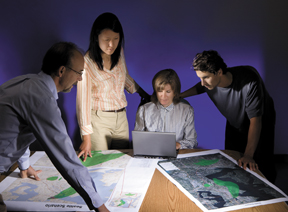
Sandia has proven to be a leading research authority when it comes to the protection of transportation hubs and large facilities against chemical or biological attack. Projects involving San Francisco International Airport and McAfee Stadium come to mind, among others.
But a terrorist event of this nature, particularly of the biological sort, could be even more catastrophic if it were carried out over a wide area, such as a large city or metropolitan region. That’s one of the main reasons why Sandia’s systems analysts and decontamination and restoration experts have been engaged in a four-year, Department of Homeland Security (DHS) and DoD-funded effort to help authorities deal with the aftermath of a biological attack.
The Interagency Biological Restoration Demonstration (IBRD) is a collaborative program to develop policies, plans, and technologies required to restore large urban areas in the event of a wide-area biological release, with a focus on civilian-military interfaces. This program is initially using the Seattle/Tacoma urban area and local military bases, such as Fort Lewis and McChord Air Force Base, in a case study. Study findings and results could potentially be applied nationally to biological restoration policy and programs.
Sandians at both the New Mexico and California sites are involved in the IBRD effort, along with key partners from Lawrence Livermore and Pacific Northwest national laboratories and oversight from DHS’ Directorate for Science and Technology (S&T) and DoD’s Defense Threat Reduction Agency (DTRA) program offices.
Gaps need to be addressed
“An anthrax attack would obviously present a huge problem for any city,” says systems analyst Lynn Yang (8114), who notes that Seattle and the surrounding Puget Sound region has been the focus of the IBRD team’s initial efforts.
“You’re talking about potentially hundreds of buildings and tens of square miles. Some regions may face a general lack of resources available to fulfill all the restoration demands in a timely fashion,” Lynn says.
Sandia and the rest of the IBRD team have been tackling the problem for about a year now. One of the initial “knowledge gaps” identified by the analysis team was that authorities currently do not know whether a contaminated outdoor area would need to be actively decontaminated, or if natural attenuation from rain and ultraviolet exposure would be sufficient. The team also has made recommendations in planning and decision making. For example, in a wide-area contamination scenario, authorities would greatly benefit from formal, agreed-upon processes to determine what buildings need attention, and in what order.
Without such processes, a city hit by an anthrax attack might attempt to clean up buildings and infrastructure in an inefficient manner. Sandia analysts have recommended that decision prioritization for cleanup should be informed by many factors, including the overall objective for restoration (e.g., maximum reoccupation in minimum amount of time), an understanding of what infrastructure is critical, and other local considerations.
To address the wide-area dilemma, Sandia has further recommended to its sponsors that they improve the technologies available to “scope” the problem more rapidly following an event.
Wayne Einfeld (6327), along with others in Sandia’s systems analysis group in California, is leading a study that is making specific recommendations to the program sponsors as to which technologies should be considered for development and what capabilities would be most beneficial. “As is usually the case, federal resources are limited, so program managers must carefully choose where to invest in technology development and application to make the biggest impact in the restoration process,” says Wayne. The analysis team is using a variety of analytical tools to provide quantitative justification for the various development options.
The IBRD team at Sandia, led by principal investigator Mark Tucker (6327), is also involved in technology development. Mark has a long history in restoration technology, having led the development of the Labs’ well-known decontamination formulation that has since been commercialized and widely used in both military and domestic applications.
Managing contaminated waste
One piece of technology that’s already been used to a large degree, Mark says, is the Sandia-developed Analyzer for Wide-Area Restoration Effectiveness, or AWARE. Currently in spreadsheet format, AWARE is a tool that looks across the full spectrum of restoration activities and analyzes each phase in terms of resources and timelines. It explores the answers to questions such as, how many teams are required to take samples in a given location. If a certain technology is introduced, does it improve or speed up the process?
Another area of focus for IBRD, Lynn says, has been how best to manage the equipment and other items in contaminated zones. Given the quantity and variation of items, including cars, furniture, and other pieces of personal property and goods that may be present, policies need to be developed that help decide what items should be disposed of (versus decontaminated). Other issues faced by decision makers include which technologies will be used to decontaminate the various categories of items and the approved protocols for transporting and handling contaminated solid waste.
Mark, Lynn, Wayne, and the other IBRD team members, including Julie Fruetel (8125), David Franco (8125), Donna Edwards (8114), Bob Knowlton (6327), Rita Betty (6327), and John Brockmann (1532), now into their second year of the program, continue to write plans, develop technology recommendations, and develop new technologies and methods for the program sponsors. Independent working groups will be considering inputs from Sandia’s investigations as well as other interagency concerns to help DoD and DHS select technologies to pursue further under the IBRD program.